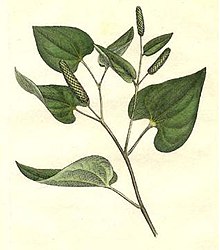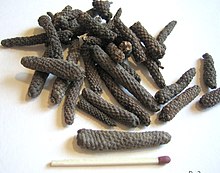Long pepper
| Long pepper | |
|---|---|

| |
| Long pepper's leaves and fruits | |
| Scientific classification | |
| Kingdom: | Plantae |
| Clade: | Tracheophytes |
| Clade: | Angiosperms |
| Clade: | Magnoliids |
| Order: | Piperales |
| Family: | Piperaceae |
| Genus: | Piper |
| Species: | P. longum
|
| Binomial name | |
| Piper longum | |
Long pepper (Piper longum), sometimes called Indian long pepper or pippali, is a
The fruit of the pepper consists of many minuscule fruits – each about the size of a
History

The oldest known reference to long pepper comes from ancient Indian textbooks of Ayurveda, where its medicinal and dietary uses are described in detail. It reached Greece in the sixth or fifth century BCE, though Hippocrates discussed it as a medicament rather than a spice.[1] Among the Greeks and Romans and prior to the Columbian exchange, long pepper was an important and well-known spice.
The ancient history of black pepper is often interlinked with (and confused with) that of long pepper, though Theophrastus distinguished the two in the first work of botany. The Romans knew of both and often referred to either as just piper; Pliny erroneously believed dried black pepper and long pepper came from the same plant.
Round, or black, pepper began to compete with long pepper in Europe from the twelfth century and had displaced it by the fourteenth. The quest for cheaper and more dependable sources of black pepper fueled the Age of Discovery.
Only after the discovery of the American continents and of chili pepper, called by the Spanish pimiento, employing their word for long pepper, did the popularity of long pepper fade away.[2] Chili peppers, some of which, when dried, are similar in shape and taste to long pepper, were easier to grow in a variety of locations more convenient to Europe. Today, long pepper is a rarity in general commerce.
Etymology
The word pepper itself is derived from the word for long pepper, Tamil word pippali.[3][4] The plant itself is a native of India. The word pepper in bell pepper, referring to completely different plants under genus Capsicum, is of the same etymology. That usage began in the 16th century.[5]
Usage


Though often used in medieval times in spice mixes like "strong powder", long pepper is today a very rare ingredient in European cuisines, but it can still be found in Indian and Nepalese vegetable pickles, some North African spice mixtures, and in Indonesian and Malaysian cooking. It is readily available at Indian grocery stores, where it is usually labeled pippali. Pippali is the main spice of nihari, a popular meat stew from India, originating in the Indian metropolis of Lucknow, and one of the national dishes of Pakistan.
See also
References
- ISBN 978-0631177418– via Internet Archive.
- ^ Hyman, Philippe; Hyman, Mary (June 1980). "Connaissez-vous le poivre long?". L'Histoire. 24.
- ISBN 9788120615496– via Google Books.
- ISBN 9788171564422– via Internet Archive.
- ^ "Pepper". Oxford English Dictionary. Vol. 7: N–Poy (1st (corrected re-issue) ed.). 1913. p. 663, definitions 1c, 2b.
- PMID 16420250.
- PMID 23619565.
